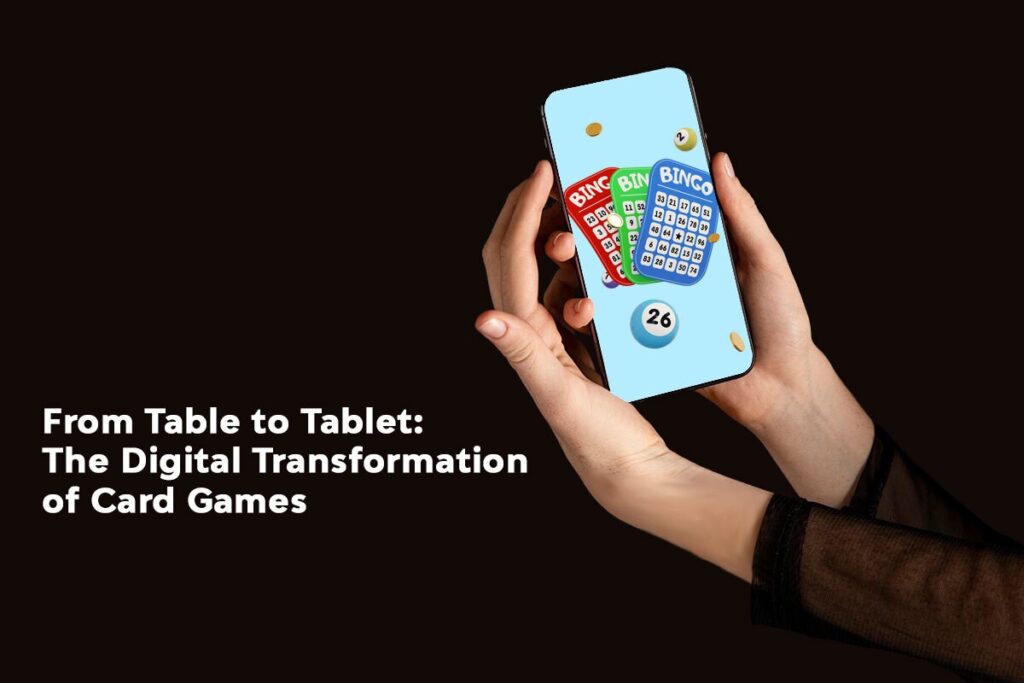Card games have been part of human entertainment for centuries, evolving from ancient tools for divination to modern, sophisticated pastimes enjoyed across the globe.
Today, the digital age has thrown card games into an entirely new realm. Once relegated to tables, these games are now thriving on tablets, smartphones, and computers, marking a significant transformation that has reshaped how we play, connect, and compete.
A Brief History of Card Games
Card games originated in China during the Tang Dynasty, circa the 9th century, when they were used both as a game and as money. This concept eventually found its way westward, where it developed into other forms.
The familiar deck of 52 cards made its debut in Europe during the 14th century, eventually spawning Poker, Rummy, and Solitaire, among other games, to become the social pastime of nearly everyone.
However, the advent of digital technology started a new chapter by reinventing these age-old games for a modern audience.
The Shift to the Digital Realm
The rise of the internet and mobile devices was pivotal in transforming card games. Developers realized that they could merge the timeless appeal of card games with the convenience and interactivity of digital platforms.
Early adaptations like Microsoft’s Solitaire on Windows paved the way, demonstrating that card games could flourish in a virtual format. As technology advanced, so did the complexity and appeal of digital card games.
Today, Steam, Google Play, and the App Store are all platforms hosting numerous card games, from the traditional adaptations to the new hybrids. Digital has preserved the legacy of card games but has also spread them further, enabling any player to play at any point in time.
Increasing Accessibility and Convenience
Accessibility is probably one of the most significant advantages of digital card games. Traditional card games require a physical deck and participants, but these barriers no longer exist in digital versions. A player can play a quick game of Poker or Bridge over lunch or play an extended session of Hearthstone or Magic: The Gathering Arena from home.
Besides, online sites also introduced tutorials and free practice modes, making it easy for newbies to learn the rules of the game. This democratized card games to new sets of players who otherwise would have been afraid of playing with more traditional setups. For example, players can learn about bingo game patterns that will help them win future matches.
The Allure of Social Connection
Contrary to the idea that digital gaming is isolating, online card games have created new social bonds. Multiplayer modes and online tournaments provide an opportunity to compete against friends or unknown people around the world. Chat features and social media integrations further enhance these interactions, transforming single-player games into community experiences.
Card games now have crossed geographical and cultural boundaries. For example, a player sitting in the USA can challenge another opponent in Brazil. Moreover, the rise of the popular esports and live streaming via Twitch has made competitive card gaming a spectator sport.
Gameplay Innovations
Digital formats have enabled innovations that are impossible to implement in a physical card format. Dynamic animations, special effects, and storytelling elements enhance the experience for game developers. Games like Gwent, Hearthstone, and Legends of Runeterra marry strategy with compelling narratives to draw an audience of many diverse kinds.
Besides, digital card games normally include updates and expansions, which keep the game exciting. Such a model not only supports the interest of players but also creates an expectation of new content.
Gamification and Rewards
Digital platforms have incorporated gamification techniques to enhance player engagement. Leaderboards, daily challenges, and in-game rewards motivate players to return regularly. Some games also include collectible elements, where players can earn or purchase unique cards to build customized decks.
Microtransactions, though a matter of controversy at times, are the norm in current models. They are optional opportunities to unlock premium content, fast-track players through, and bring quite nice income for developers. Beyond fair access, and whether that would hurt the whole economy or not, it became highly profitable and promoted the development of the market with digital card games.
The Role of New Technology
Advancements in technology have greatly contributed to the digitalization of playing cards. Advanced opponents can be easily encountered through artificial Intelligence. These opponents prove very challenging, even if players play solo. For example, in multiplayer options, artificial Intelligence helps create a level match between competitors and players.
Blockchain technology and non-fungible tokens (NFTs) are new trends that allow for unique ownership of digital cards and ensure secure transactions. Such innovations open new avenues for monetization and personalization, attracting casual players and serious collectors alike.
Conclusion: The Future of Digital Card Games
Digital card games are certainly going to have a bright future because of technological advancement and the shifting preferences of the players. Virtual Reality (VR) and Augmented Reality (AR) will most probably play a big role as they can give the best immersive experience, which bridges the gap between digital and physical gaming. Imagine sitting at a virtual table with friends wearing a VR headset or projecting a game onto your living room table with AR.
Artificial Intelligence will enhance the gameplay further, producing much more adaptive and intelligent opponents.Blockchain technology might redefine ownership and trading to where digital cards are worth exactly as much as physical cards.
Another aspect that brings card games into greater scope is when they get mixed with larger gaming systems or metaverses, enabling new modes of interaction and creativity. Players might build their own cards or even rules for the game in a dynamic and always-evolving gaming world.

